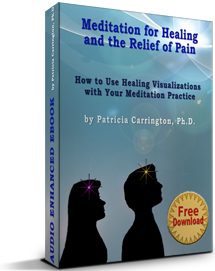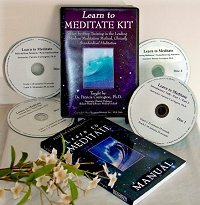Dr. Patricia Carrington's award winning meditation technique CSM (Clinically Standardized Meditation) is a clinically sensitive meditation method developed by the Medical Department of New York Telephone Company and used by numerous medical institutions, organizations, and individuals worldwide. For information click here.
Meditating to Reduce Stress
Combating Physical Illness with Meditation
Patricia Carrington, Ph.D.
Author of “The Book of Meditation”
I have already spoken of Dr Herbert Benson’s work. His interest in meditation commenced because he envisioned its possible use in combating the ‘fight or flight’ response, a physiological reaction which releases emergency mechanisms in the body which speed the flow of blood to muscles, thereby preparing the animal or person either to fight an enemy or to run from danger.1
We need this hair-trigger survival response if we are jungle dwellers, are on a battlefront, or are facing any other situation involving an immediate threat to our life. This emergency response is not appropriate, however, in dealing with most everyday problems. The tensions that civilized people face usually cannot be physically fought or taken flight from – they are continuous. Our ‘enemies’ are all too often such things as concern about holding onto a job, about managing difficult relationships, about finances, about measuring up to competition, or other present-day stresses. Effective handling of these threats is hampered by physiological reactions such as a pounding heart, too rapid breathing, or spiraling blood pressure – the hallmarks of the fight or flight response.
Incorrectly used over a period of time, this response can be very harmful. When the body repeatedly mobilizes itself to deal physically with threats from which it cannot escape and which cannot be fought physically, this eventually results in permanent changes to the body which may damage health.
For example, the blood vessels may become more constricted and remain that way if the fight response is too often evoked in situations where fight is impossible. The person with chronic high blood pressure (hypertension) seems continually geared for a fight or a flight that cannot be made. This means that those emergency responses of the body, which were so useful under primitive conditions, have now become a disadvantage.
Because of these dangers, Benson reasoned that a technique which might relax the inappropriate fight-flight reaction and allow a natural counter-reaction (he called this the ‘relaxation response’) might be an effective way of altering the unhealthy physiology of the hypertensive patient. He pointed out that the relaxation response appears to be as much a part of our inherited equipment as is the fight-flight response although it is not easily evoked in a high-pressure society that demands that its members move at a fast pace, continually punch real or imagined time clocks, and constantly measure up to invisible yet threatening demands.
Benson was impressed when the studies on meditation which he conducted with Wallace showed that a profound state of relaxation could be brought on simply by practicing TM. Later he was able to demonstrate that this same state of deep
|
MEDITATION AUDIO LESSON Meditation for High Blood Pressure
Scientific research has shown marked improvement in high blood pressure and bronchial asthma for people who meditate and Dr. Carrington, in her practice, has also seen people who meditate find relief from tension headaches.
|
physiological relaxation could be induced by using his own form of meditation. To date he and his associates have studied the effects of both TM and his own meditation method with hundreds of hypertensive patients, and many other researchers have studied meditation’s effects on hypertension as well.2
While many of these patients have shown significant and sustained decreases in their blood pressure after about two months of meditation practice, others have shown only slight effects, if any. In Benson’s studies, the patients’ systolic readings (the blood pressure during the contraction of the heart) dropped on average about ten points and their diastolic readings (the blood pressure during the expansion of the heart) about five points – scarcely dramatic results but in the right direction. Many borderline hypertensive patients (whose blood pressure reading is just on the upper limit of what is considered the normal range) have achieved normal blood pressure after they have learned to meditate and a few patients have even been able to reduce the dosage of any anti-hypertension drugs they have been taking.
Benson emphasized that regular practice was essential in order to maintain these good results. Those hypertensive patients who responded well to meditation were able to keep their blood pressure down only if they continued to meditate regularly. If for any reason they discontinued the practice, their pressure would gradually drift back up again. Meditation seems to be like a change in diet which eliminates symptoms only as long as the diet is faithfully adhered to. It is therefore a preventive measure rather than a ‘treatment’. It must become a permanent way of life if a person is to gain lasting benefits.
Since bronchial asthma is also recognized as a tension-related disease, researchers Honsberger and Wilson reasoned that it too might respond to meditation.3 When they studied a group of asthmatic patients in the University of California Department of Medicine, they discovered that after beginning the practice of meditation, 94 percent of these patients showed improvement in their asthma symptoms as determined by measurements of their ‘airway resistance’ (a test of free breath flow). The personal physicians of 52 percent of them also rated their patients’ conditions as ‘improved’, and 74 percent of the patients themselves reported their own condition to be ‘improved’. Another group of asthmatic patients who simply read material about meditation for twenty minutes every day (but did not learn to meditate) showed no improvement. These were promising results.
Meditation is also frequently used to combat tension headaches. It has proven effective in a number of cases of headache that I have treated, and research studies have shown similar results.4 I have received reports from psychotherapist colleagues on about a dozen patients who have learned meditation because they hoped to rid themselves of incapacitating tension headaches and in each of these cases, the headaches improved with meditation. In many instances they were eliminated. Once again, continued regular meditation seems crucial. If these patients stopped meditating, their headaches returned.
Migraine headaches (very different physiologically from tension headaches) may not respond as well to meditation. According to Benson, of seventeen patients suffering from severe migraine headaches studied at Boston’s Headache Foundation, only three were helped by the regular practice of TM and one subject was actually ‘made worse’.5
1. H. Benson, The Relaxation Response (New York, Morrow, 1975). M. Shafii, ‘Smoking Following Meditation’ (unpublished paper, University of Michigan Medical
2. R. H. Schneider, F. Staggers, C. N. Alexander et al., ‘A Randomized Controlled Trial of Stress Reduction for Hypertension in Older African Americans’, Hypertension, 26 (1995), pp. 820–27; C. N. Alexander, R. H. Schneider, F. Staggers et al., ‘Trial of Stress Reduction for Hypertension in Older African Americans. II. Sex and Risk Subgroup Analysis’, Hypertension, 28 (1996), pp. 228–37. P. Gelderloos, K. G. Walton, D. W. Orme-Johnson et al., ‘Effectiveness of the Transcendental Meditation Program in Preventing and Treating Substance Misuse: A Review’, International Journal of the Addictions, 26 (3) (1991), pp. 293–325.; C. N. Alexander, P. Robison and M. Rainforth, ‘Treating and Preventing Alcohol, Nicotine, and Drug Abuse Through Transcendental Meditation: A Review and Statistical Meta-Analysis.’, Alcoholism Treatment Quarterly, 11 (1–2) (1994), pp. 13–87.
3. R. Honsberger and A. F. Wilson, ‘Transcendental Meditation in Treating Asthma’, Respiratory Therapy: The Journal of Inhalation Technology, 3 (1973), pp. 79–81.
4. M. P. Sharma, V. Kumaraiah, H. Mishra et al., ‘Therapeutic Effects of Vipassana Meditation in Tension Headaches’, Journal of Personality and Clinical Studies, 6 (1990), pp. 210–16; A. Vasudevan, V. Kumaraiah, H. Mishra et al., ‘Yogic Meditation in Tension Headache’, NIMHANS Journal, 12 (1994), pp. 69–73.
5. Benson, op. cit., p. 109.


